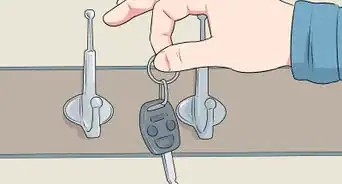This article was co-authored by Katherine Kirkinis, Ed.M., MA. Katherine Kirkinis is a Career Coach and Psychotherapist who has served as a career expert for Forbes, Medium, Best Life, and Working Mother Magazine, and as a diversity and inclusion expert for ATTN and Quartz. She specializes in working with issues of career, identity, and indecision. She has doctoral-level training in career counseling and career assessment and has worked with hundreds of clients to make career decisions through career assessments. She is pursuing a doctoral degree at The University of Albany, SUNY where her work focuses on diversity and inclusion, racism in the workplace, and racial identity. She is a published author and has been featured in academic journals as well as popular media outlets. Her research has been presented at 10+ national APA conferences since 2013.
This article has been viewed 373,547 times.
In most networking situations, you don’t have much time to introduce yourself and lay out your goals and accomplishments. Developing an elevator pitch that emphasizes your key qualification and accomplishments and keeps your listener engaged can help you make the most of the time that you have. Practicing your pitch until you sound confident and professional can help you deliver an effective pitch.
Steps
Determining Your Key Points
-
1Tell your listener who you are and what you do. The very first thing your pitch should do is introduce you to your listener. Immediately launching into an anecdote about your accomplishments or a list of your skills might leave your listener feeling a little bewildered.
- For example, you can start by saying something like, “Hi, I’m Amanda Smith. I just recently graduated from the University of Maine’s marketing program,” or, “Hi, I’m Ryan Long and I work in manufacturing sales.”
- In both examples, your listener immediately learns your name and the most important thing about you.
-
2State your objective. Now that your listener knows who you are, tell them why you are at the event you’re both attending. It might be a job fair or an industry conference or you might just be dropping off a resume. In each situation, you should know why you’re there.[1]
- For example, if you’re attending a job fair, your objective is probably to get a job. You could say something like “Hi, I’m Amanda Smith. I just recently graduated from the University of Maine’s marketing program. I’m looking for an entry-level position in social media coordination.”
- You could also say something like, “Our auto parts manufacturing business has been growing, but I’m looking to take our sales numbers to record-breaking heights.”
- In both examples, your listener has learned who you are, what you do, and what you’re looking for next in only two sentences.
-
3Share your accomplishments. The best way to convince your listener that you can reach your stated objective is to share past successes.[2] This tells your listener that you already have a good track record in your field. Use the CAR technique for this: Give the context for your accomplishment, the action you took, and the result of that action.[3]
- For example, your accomplishment might be that you improved your company’s sales over the last quarter. The context might be that sales were okay, but you believed they could be better. Your action might have been that you sat down with the sales team and reworked your entire selling strategy. Your result was that your company’s sales increased.
-
4Share your skills. Telling your listener what skills you have allows you to emphasize what you can do for them in the future (and not just what you’ve already done for someone else in the past). Share both your hard skills – things like degrees, certifications, and work experience – and your soft skills – things like being good at interpersonal communication or an excellent writer.[4]
- For example, you might say something like “I have a Master’s Degree in Business and worked for eight years as the assistant sales manager for a smaller auto parts manufacturer. My superiors have always commented on my ability to communicate clearly and effectively with our clients.”
-
5Close with a call to action. Your call to action is basically what you can do to seal the deal after you’ve made the pitch. This will look differently from situation to situation, but it should set up the next step in your relationship with this new contact.[5]
- For example, you can end your pitch by saying something like “Can we set up a meeting to discuss how I can increase your company’s sales?” You can also end it more simply by saying “I think I could be a great asset to your company; can I give you my business card?”
Making Your Speech Engaging
-
1Make eye contact. When you’re giving your pitch, don’t stare at the floor or the ceiling or your listener’s shoulder. Look them in the eye while you’re speaking to them. This can make your listener feel more connected and you seem more professional.
-
2Be confident. Introducing yourself to a complete stranger and then listing your accomplishments and goals can make you feel very vulnerable. However, acting confident even if you don’t necessarily feel that way can make a big difference in how your listener perceives you. If you sound like you believe you are qualified for a new position or can accomplish the goals you lay out, your listener is more likely to believe it, too.
-
3Use attention-grabbing and descriptive words. The best way to keep your listener engaged is to use words that grab their attention. One of the reasons some people sound as if they speak with low energy if because of their word choice.
- Some examples of attention-grabbing and descriptive words include "immediately," "guaranteed," "instantly," "explosive," "exclusive, "amazing," "eye-opening," and "fearless."
-
4Pay attention to body language. You want to make sure that you seem friendly, open, and inviting as you give your pitch, and the best way to do this is through body language. Face your listener straight on, keep your hands out of your pockets, and stand up straight.[6]
-
5Share your motivation. The most engaging elevator pitches are those made by people who make you care about what they are saying. A good way to get your listener to care is to share your motivation for meeting certain objectives.[7]
- For example, your motivation for increasing your company’s sales numbers might be that you believe that the services your company provides will truly improve your clients' quality of life. This is an excellent motivation beyond wanting more clients or to make more money.
- You can say something like “I spent a few weeks on a study abroad trip in India, where I learned just how important clean drinking water is to a family’s overall health. I believe that getting our water filters into as many homes as possible will truly help to improve our clients’ and clients’ families’ quality of life.”
-
6Avoid jargon specific to your field or company. The quickest way to lose someone’s attention during an elevator pitch is to use field- or company-specific jargon. If your listener doesn’t understand what you’re saying, they won’t stay engaged for long. The simpler and more direct your language, the better.[8]
-
7Show interest in your listener. When you’re giving your pitch, don’t just drone on to the end of it and then walk away. Ask your listener questions – what do they do for a living? Where did they go to school? Showing interest in your listener makes your pitch part of a conversation and not just a monologue.[9]
Practicing Your Speech
-
1Time yourself. Once you have what you feel like is a good draft of your elevator pitch, time how long it takes you to say it out loud in a conversational manner. Set a timer on your phone or computer or just by looking at your watch, and see if you can share everything you need to in 60 to 90 seconds.
- If it takes you longer than 60 to 90 seconds, don’t just speed up. If you speak too quickly while you’re giving your pitch, it will become obvious to your listener that you’re giving them a canned speech, and they’ll likely lose interest.
-
2Revise your pitch. Once you’ve said your pitch out loud a few times, you’ll want to revise it. It might be too long, which requires streamlining some of the information you include. You should also continuously update your pitch to include new experiences and skills or changing goals.[10]
-
3Tweak your pitch for each new situation you're in. You won’t be giving your elevator pitch to the same person in the same situation every time you give it. Make sure you practice your speech before each new event or situation and tweak it to match.
- For example, if you’re at a career fair, you’ll want to emphasize goals that relate to getting a job (or changing jobs) and the skills that make you an excellent new addition to an existing team.
- If you’re going to a networking event that might help you expand your client base, emphasize the goals related to customer retention and the skills and accomplishments that will attract new customers to you.
-
4Don't practice too much. Although you should practice enough that you can comfortably share everything you want to say within your time limit, you shouldn’t over-practice. If you do, your pitch will end up sounding rehearsed and, even worse, you could sound bored when you’re saying it. You should know what you want to say but it should also sound fresh.
-
5Ask friends to listen. Once you feel comfortable with your pitch, ask at least one of your friends to listen to it and offer feedback.[11] They can help you determine if you’re speaking too quickly, if you sound too rehearsed, and if you’re engaging.
Expert Q&A
-
QuestionWhat do I include in a personal pitch?
 Katherine Kirkinis, Ed.M., MAKatherine Kirkinis is a Career Coach and Psychotherapist who has served as a career expert for Forbes, Medium, Best Life, and Working Mother Magazine, and as a diversity and inclusion expert for ATTN and Quartz. She specializes in working with issues of career, identity, and indecision. She has doctoral-level training in career counseling and career assessment and has worked with hundreds of clients to make career decisions through career assessments. She is pursuing a doctoral degree at The University of Albany, SUNY where her work focuses on diversity and inclusion, racism in the workplace, and racial identity. She is a published author and has been featured in academic journals as well as popular media outlets. Her research has been presented at 10+ national APA conferences since 2013.
Katherine Kirkinis, Ed.M., MAKatherine Kirkinis is a Career Coach and Psychotherapist who has served as a career expert for Forbes, Medium, Best Life, and Working Mother Magazine, and as a diversity and inclusion expert for ATTN and Quartz. She specializes in working with issues of career, identity, and indecision. She has doctoral-level training in career counseling and career assessment and has worked with hundreds of clients to make career decisions through career assessments. She is pursuing a doctoral degree at The University of Albany, SUNY where her work focuses on diversity and inclusion, racism in the workplace, and racial identity. She is a published author and has been featured in academic journals as well as popular media outlets. Her research has been presented at 10+ national APA conferences since 2013.
Career Coach & Psychotherapist Walk through your most recent job history and your experience that matches the career you're looking for.
Walk through your most recent job history and your experience that matches the career you're looking for. -
QuestionHow long should a personal pitch be?
 Katherine Kirkinis, Ed.M., MAKatherine Kirkinis is a Career Coach and Psychotherapist who has served as a career expert for Forbes, Medium, Best Life, and Working Mother Magazine, and as a diversity and inclusion expert for ATTN and Quartz. She specializes in working with issues of career, identity, and indecision. She has doctoral-level training in career counseling and career assessment and has worked with hundreds of clients to make career decisions through career assessments. She is pursuing a doctoral degree at The University of Albany, SUNY where her work focuses on diversity and inclusion, racism in the workplace, and racial identity. She is a published author and has been featured in academic journals as well as popular media outlets. Her research has been presented at 10+ national APA conferences since 2013.
Katherine Kirkinis, Ed.M., MAKatherine Kirkinis is a Career Coach and Psychotherapist who has served as a career expert for Forbes, Medium, Best Life, and Working Mother Magazine, and as a diversity and inclusion expert for ATTN and Quartz. She specializes in working with issues of career, identity, and indecision. She has doctoral-level training in career counseling and career assessment and has worked with hundreds of clients to make career decisions through career assessments. She is pursuing a doctoral degree at The University of Albany, SUNY where her work focuses on diversity and inclusion, racism in the workplace, and racial identity. She is a published author and has been featured in academic journals as well as popular media outlets. Her research has been presented at 10+ national APA conferences since 2013.
Career Coach & Psychotherapist You're usually safe to keep your pitch between 2–2.5 minutes, but avoid going too much longer.
You're usually safe to keep your pitch between 2–2.5 minutes, but avoid going too much longer. -
QuestionCan I use the fact that I want an investment as an elevator pitch?
 Community AnswerI would say only if the investment somehow improves the listener's situation.
Community AnswerI would say only if the investment somehow improves the listener's situation.
References
- ↑ https://www.idealist.org/en/careers/a-quick-guide-to-writing-your-elevator-pitch
- ↑ Katherine Kirkinis, Ed.M., MA. Career Coach & Psychotherapist. Expert Interview. 14 October 2020.
- ↑ https://www.workitdaily.com/elevator-pitch-developing-winning/
- ↑ Katherine Kirkinis, Ed.M., MA. Career Coach & Psychotherapist. Expert Interview. 14 October 2020.
- ↑ http://sfp.ucdavis.edu/files/163926.pdf
- ↑ https://www.mindtools.com/pages/article/elevator-pitch.htm
- ↑ https://www.mindtools.com/pages/article/elevator-pitch.htm
- ↑ http://theinterviewguys.com/write-elevator-pitch/
- ↑ https://www.mindtools.com/pages/article/elevator-pitch.htm
- ↑ https://www.workitdaily.com/elevator-pitch-developing-winning/
- ↑ Katherine Kirkinis, Ed.M., MA. Career Coach & Psychotherapist. Expert Interview. 14 October 2020.




































